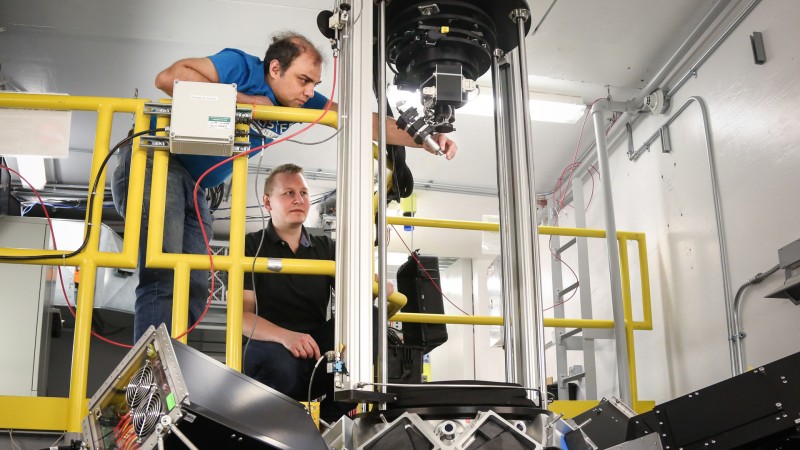At first glance, biomedical imaging devices, cell phones, and radio telescopes may not seem to have much in common, but they are all examples of technologies that can benefit from certain types of relaxor ferroelectrics—ceramics that change their shape under the application of an electric field.
Electromechanical properties within these materials are strongest at specific combinations of temperature and applied electric fields. Two former postdoctoral researchers at the US Department of Energy’s Oak Ridge National Laboratory (ORNL) are returning to their neutron sciences roots at the ORNL Spallation Neutron Source (SNS) to study this phenomenon.
Colleagues and frequent collaborators Abhijit Pramanick from the City University of Hong Kong and Mads Ry Jørgensen from Aarhus University in Denmark first met during the National School on Neutron and X-Ray Scattering (NXS) in 2008. Their latest project involves applying electric fields and varying temperatures to single-crystal samples using the TOPAZ instrument, SNS beam line 12, to examine how the material’s atoms are displaced under those conditions. They say a better understanding of the material’s behaviors should aid in the development of new relaxor ferroelectric designs with improved properties—and possibly ones that are more ecofriendly, too.
“Interestingly, when you expose this material to certain temperatures under certain electric fields, you get a big increase in electromechanical responses,” Pramanick said. “But we don’t really understand why it happens under such conditions. We are trying to understand the atomistic mechanism.”
Jørgensen, who also manages the DanMAX beam line at the MAX IV Laboratory in Sweden, explained that the fine details of how these materials work remains a popular subject of ongoing research because scientists have been studying these mechanisms for more than 50 years without conclusive results.
For answers, the team turned to neutrons. Neutrons provide a nondestructive probe researchers can use to interact with materials to collect data about the materials’ atomic structures and behaviors.
“What’s really interesting is the combination of high temperatures and electric fields. When you are trying to implement that for very small crystals like the ones we’re using here, that’s a very difficult experiment to do,” Pramanick said.
“Normally, studying these crystals would be like standing on one side of a building but needing to walk around the entire perimeter to get a full view,” Jørgensen said, “but TOPAZ provides a comprehensive view of all four sides at once, which allows us to probe the diffraction pattern in 3-D without rotating the sample.”
The researchers are also investigating the significance of lead in ferroelectric materials. An essential component of relaxor ferroelectrics, lead also poses environmental risks, from contributing to air pollution to negatively affecting fragile ecosystems.
“We need to learn what makes lead so important,” Pramanick said. “If we can understand the atomistic mechanisms better, we can design new materials that are more environmentally friendly but still achieve similar properties.”
Both researchers are thrilled to pursue these goals at SNS. “It’s always good to come back,” Pramanick said. “We love seeing how the facility continues to grow.”
SNS is a Department of Energy Office of Science User Facility. UT-Battelle manages ORNL for the DOE’s Office of Science. The Office of Science is the single largest supporter of basic research in the physical sciences in the United States, and is working to address some of the most pressing challenges of our time. For more information, please visit http://science.energy.gov/.—by Elizabeth Rosenthal





